The Edigin N'Use, the Oba of Benin and the Akhue Game : Naming, Identity, Transformation : Developing the Philosophical and Mystical Possibilities of the Coronation Ceremonies of the Oba of Benin
Oluwatoyin Vincent Adepoju

The Edigin N'Use, the Oba of Benin and the Akhue Game
An exploration of the visual and symbolic power of the stage in the coronation of the Oba of Benin represented by the Crown Prince travelling to Use to engage in the Akhue game with the ruler of Use, the Edigin N'Use, in order, through the permutations of the game, to arrive at the name he will be known by after his coronation as Oba, as represented by the last coronation, in October 2016, of His Royal Majesty Oba Ewuare II.
This essay is organised in terms of verbal text framing the entire work and pictures with complementary text responding to the aesthetic and symbolic force of the pictures. The pictures come from various sources, often uploaded to the social media site Facebook by eyewitnesses at the time of the coronation, as well as images of Benin sculpture from art gallery and essay presentations that may be seen as amplifying the symbolism of the conflations of history represented by the tradition of the Akhue game.
Inspired by Victor Ekhator's pictures of the coronation in his Facebook account, I am preparing a website, essays, book and basic film project exploring the visual and philosophical values of the coronation, viewing it as a mystical progression involving the synergy of the spectators, the participants and the dwellers in and scions of Benin, centred in the Oba as an individual as well as representative of an ancient ancestral line, operating within the matrix represented by the ultimacies embodied by Olokun and Osanobua, Olokun the spirit of all waters, mirror and child of Osanobua, the ultimate creator in Benin cosmology.
The first essay in this project, a statement of purpose and method, has been published at my blog "Great Benin" and other platforms as "Developing the Philosophical and Mystical Possibilities of the Coronation Ceremonies of the Oba of Benin"
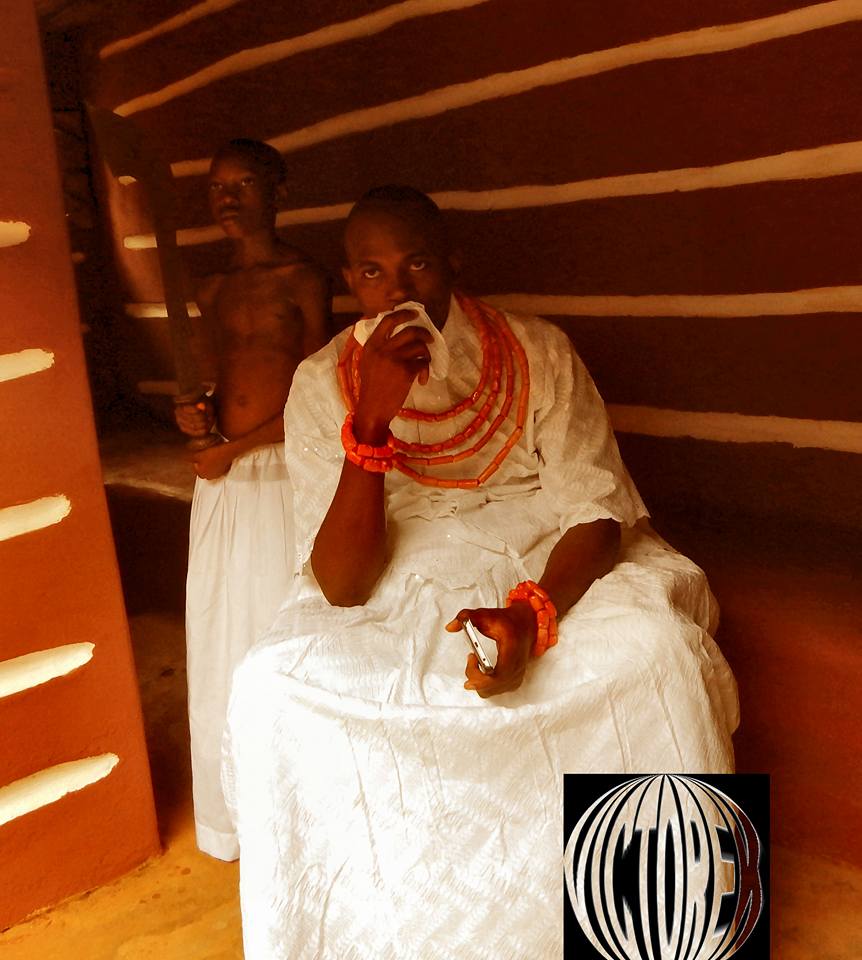
Contents
Image Sequence: Sculptural Resonances
Temporal Conjunctions through Ukhurhe and Ikegobo
A Chief’s Altar Commemorating his Paternal Ancestors
Altar to the Hand of Ezomo Ehenua (Ikegobo)

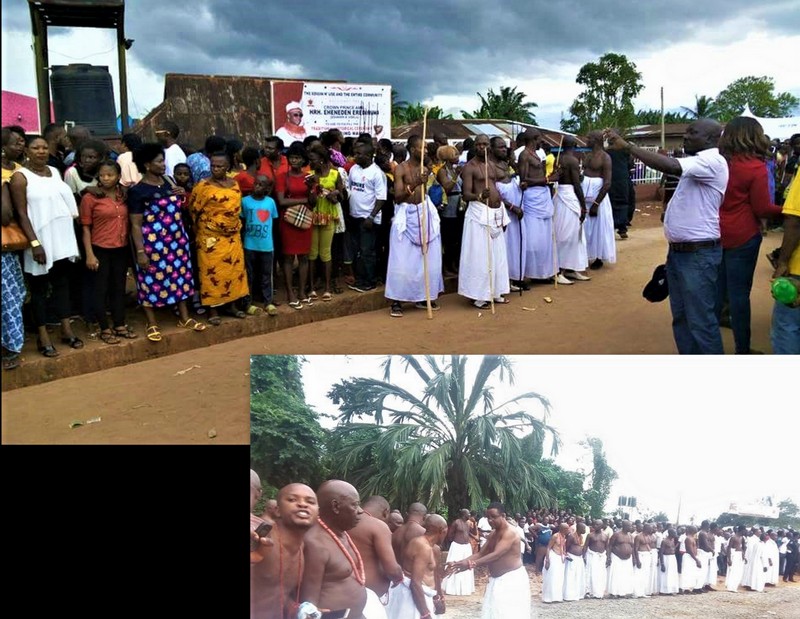
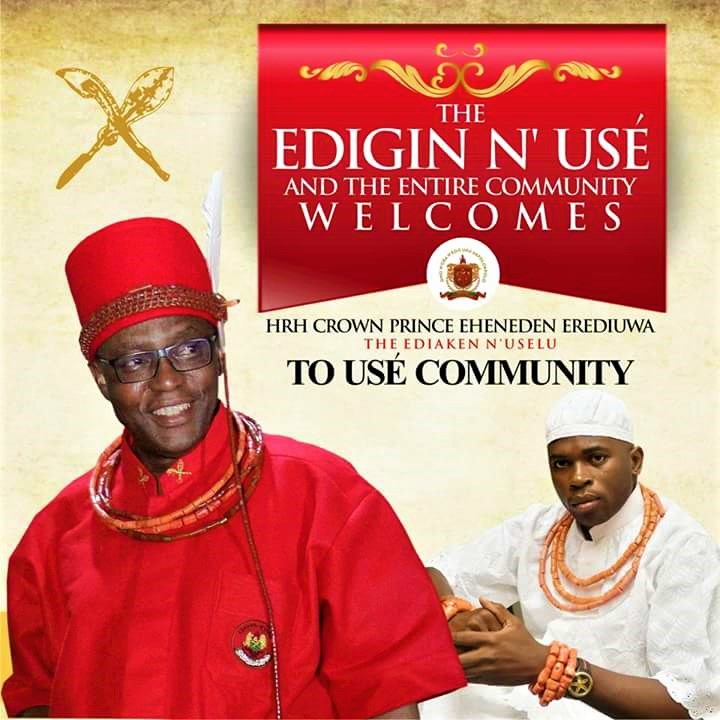
"the clan head of the Edigin Family. He plays the popular Akhue or marble seed game with the crown prince of Benin Kingdom. The game is equally played in his palace. From this game of Akhue any incoming Oba of Benin takes his second name which officially becomes his tittle. This title establishes his reign and lineage. Every Oba has a birth name and another new name secured from the playing of the Akhue game at the Edigin palace in Use. The custodian of this culture is the Edigin N Use".

The Edigin N'Use Awaiting the Crown Prince in the Former's Palace
I am struck by the paradoxical dynamism of the image. A seated man, but one clearly alert, his sense of keen alertness amplified by the presence of the ceremonial, sword carrying, bare chested youth behind him, as the characteristic spatial composition in Benin architecture represented by white lines in grooves run in parallel formation on a red earth wall, the lines seemingly escalating into infinity, generating a sense of expansiveness even within the clearly confined space within which the main figure, represented by the Edigin, and the secondary figure, the sword bearer, are positioned.
The deep red earthen colour of the surrounding walls, made of Benin earth, earth carrying the memories of generations from beginnings deep in unknown history, suffuses the space. Colour conflating ancientness and presentness, nature embodied by earth and the demonstration of human creativity in building architectural forms using the primordial substance of terra firma, along with the white regalia and red beads of the Edigin , generating symbolic contrasts and harmonies, shape the visual and associational luminosity of this image.


The Edigin and his Court Rise as the Crown Prince Approaches
The Edigin and his court rise to welcome the Crown Prince, news of the nearness of whose approach to Use has reached them. I understand the Oba has walked rather than been driven, the act of walking rather than using a car, along with walking to various sites strategic to Benin history and cosmology as central to the coronation ceremonies suggesting identification with the earth which many have walked before him and will walk after him, in a culture where earth, in its mixture with water, is sacred, evoking the unity of complementary opposites that defines existence.
The absolute majesty of their stance, particularly that of the Edigin, is wonderful. The Edigin's youth is highlighted by his regal bearing and the much older age of most of the chiefs who flank him, suggesting the character of Benin primogeniture in relation to the responsibilities of the first son which cannot be superseded by any one else, regardless of their standing in the family. The picture at the bottom, suggesting a balance of tension and composure in the Edigin's stance, reinforces this sense of a weighty but ennobling calling. The superbly deigned and exquisitely sewn traditional Benin regalia he is putting on, simple but regal, projects the harmony of solemnity and beauty evoked by that this occasion, in particular, and by the coronation as a whole.
Top image from Victor Ekhator's Facebook account
Abieyuwa Edigin, described as a highly placed member of the Edigin family in the hierarchy of the Edgin Palace, in "Benin Crown Prince to Announce Coronation Name Thursday" , a Nigeria Newspapers report of October 19, 2016, tells us more about the Akhue game:
"Abieyuwa Edigin... said the Akhue game was the climax of all the coronation ceremonies. .... a cultural and traditional requirement that must be fulfilled by the crown prince before he could be crowned as Oba. Abieyuwa explained that the former Oba also played the Akhue game with Kelvin’s father, Robert Edigin, before choosing the name 'Erediauwa’ (I have come to strengthen and prosper my people) .
He said the tradition started in 1200 AD during the period of Oba Eweka, whose maternal grand-father, Ogie-Egor, lived in the nearby village of Egor, in the present Egor Local Government area of Edo. According to him, when Prince Oromiyan left Benin, he left his pregnant wife in the care of her father, the Ogie (Duke) of Egor.
He said Oromiyan’s wife delivered a male child who was dumb from birth and was sent to the maternal grand-father at Use for treatment. But as the child could still not talk after [treatment], words were sent to his father at Uhe, who then sent seven magical Akhue with which the dumb prince participated in the popular village game known as Akhue. And [ while playing this game on a particular occasion] with only one seed remaining on the ground after every other player had failed to strike it, the young prince used the magical Akhue from his father and struck the last seed.In his excitement, he spoke for the first time and exclaimed the word `Owomika’ (my hand has struck it) later corrupted to Eweka, ' he said."
Tim Jules Hull's magnificent film The Voice of Akhue brings alive the spell binding character of this story, suggesting its relationship to civilization generally and to the human mind. The narrative projects a transformation of identity at the intersection of self and social consciousness summed up in its rich resonance by Donpedro Obaseki in his essay, "Reaction to Many Current Social Media Appellations of The OBA" published on his Facebook page on the 1st of November 2016, shortly after the Oba's coronation :
" In our Pantheon and Worldview, There's no one known as 'Oba Erediauwa Akenzua'. Such [ and] similar references are anathema to our collective Edo Pantheon and Heritage. Once-upon-a-not-so-distant-past, there was a Crown Prince, Solomon Igbinoghodua Aisiokuoba Akenzua. On the Ascension to the Revered Royal Throne as Omo n'Oba n'Edo, Uku Akpolokpolo Erediauwa, SIA (as he was called by close aides and his Children) ceased to exist, by nomenclature.Same goes for our new Home Leopard [ an honorific reference to the Oba].
Ekpen'Owa. Ovbi'Adimila. Oba nòma gi'uyi'Edo de, [ salutations to the Oba in terms of the new identity he has assumed] Oba Ewuare II [ the Oba's new formal name, indicating a symbolic identity, emerging through the Akhue game, in the lineage of Benin Obas ].
He has ascended the ancient throne of Eweka I, Ewuare N'Ogidigan, Ehengbuda n'Obo, Ovonramwen n'Ogbaisi, Akenzua n'Isonorhò, Erediauwa n'òdia Edo hia [ evocation in the Edo language, of the ancestral continuity of Obas, invoking particular points in this historical progression represented by specific Obas and stretching to the first Oba from whom the lineage of Obas began].
On that Day, 11 days ago, Crown Prince (Amb) [former ambassador of the Federal Republic of Nigeria] Eheneden Erediauwa ceased to exist, albeit nomenclaturally.
There is space only for ONE SUN in the Sky. The Sun does not twinkle. It SHINES. One Sun dusks, and another now Dawns in its stead. And that SUN is the Home Leopard. Ekpen'Owa. The Lion of the Jungle. Panther of the Trees. Ruler of all Edo and all that is Edo. His Royal Majesty, Òmò n'Òba n'Èdo, Uku Akpolokpolo , Ewuare II. Continued, but ill-informed references to HRM Oba Ewuare II, in his "before BORN Again" Prince status, is unEDO. He is NOT Eheneden (even though he once was).
He is OBA. Our OBA is our OBA. No less. Umogun gha t'òkpere. Tu gha dia mi'Edo ugamwen. Emwin hia fè fè fè nu khian ya ri'Oba yan Edo, eròkpa ghi vbe wè. Oba n'Edo gha t'òkpere. Isè! Okpi'Oba PEDRO OBASEKI, PhD [ Salutations of the Oba concluding with the writer's title, possibly as a chief of the palace, granted in recognition of his cultural and academic achievements, and concluding with his summative academic qualification]."
The climax of the coronation pilgrimage in the Crown Prince’s journey to Use to engage with the Edigin N'Use, the clan head of the Edigin family, in playing the Akhue game through which the Crown Prince will assume the new name he will bear as Oba, is a process that reflects, par excellence, the concretisation of these ceremonies in some of the most fundamental and yet far reaching understanding of how humanity makes meaning out of what would have been the otherwise instinct driven progression of pure survival that is the most basic level of human existence, naming being core to human identity as affirming both individuality and the relationship between the individual and the social, symbolizing the emergence of one's humanity out of a biological substratum, and, in this instance, encapsulating the values represented by the ancient and yet continually re-energised identity that is the Obaship.
The generally understood values of naming achieve greater depth in the context of the historical account that grounds the Use naming rite. The story projects the idea of the name that is not given to one but is uttered by oneself as a demonstration of one's arrival at a climatic point of self awareness. Within that brief story a wealth of ideas is already evident or suggested, ideas that radiate in many directions across various cultures and temporal zones, from conceptions of names as social conventions integrating associations encapsulating a person's history as it is filtered through its perception by that person and others, to the more remote perception of names as embodiments of the metaphysical essence of a phenomenon, integrating the ultimate potential of their referent, cosmic matrices, metaphysical permutations articulating, in their own distinctive ways, the sonic vibrations constituting the originating and structuring forces of the cosmos.
The Crown Prince moves from Uselu to Use and then into the heart of Benin for his coronation, traversing space as a way of navigating centuries of history represented by the locations at which he stops to engage in various ritual actions and other performances. The playing of the Akhue game in such a profoundly transformative context, nine centuries after the event described as initiating it took place, testifies to the power of symbolism to continually ignite meaning beyond the limitations of temporality enforced by nature.
Will this game continue to be played centuries from now, after everyone on the earth at this period would have long departed?
Preparations for and Different Stages in the Playing of the Akhue Game as Seen from Various Angles
Live Video by Jack Obinyan of Edigin Palace Courtyard Before and During the Akhue Game
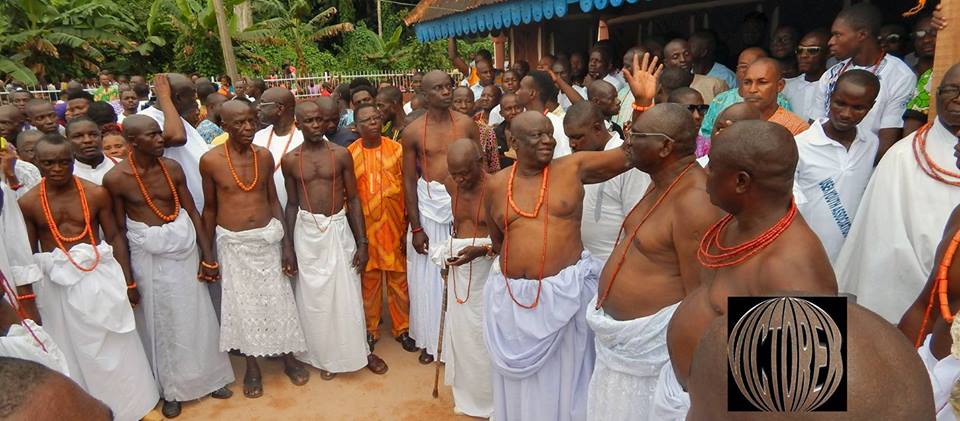
Striking about this image is the scope of human action it encompasses. The mood is solemn but expectant. An elderly chef is active on his mobile phone. Another beside him in restrained excitement as befits the serious and yet heart quickening context, acknowledges someone in the crowd. Beyond the human activity, the grove broods in its self contained universe, its density enclosing a world parallel to the human but vital to humanity in its efforts at self enhancement.
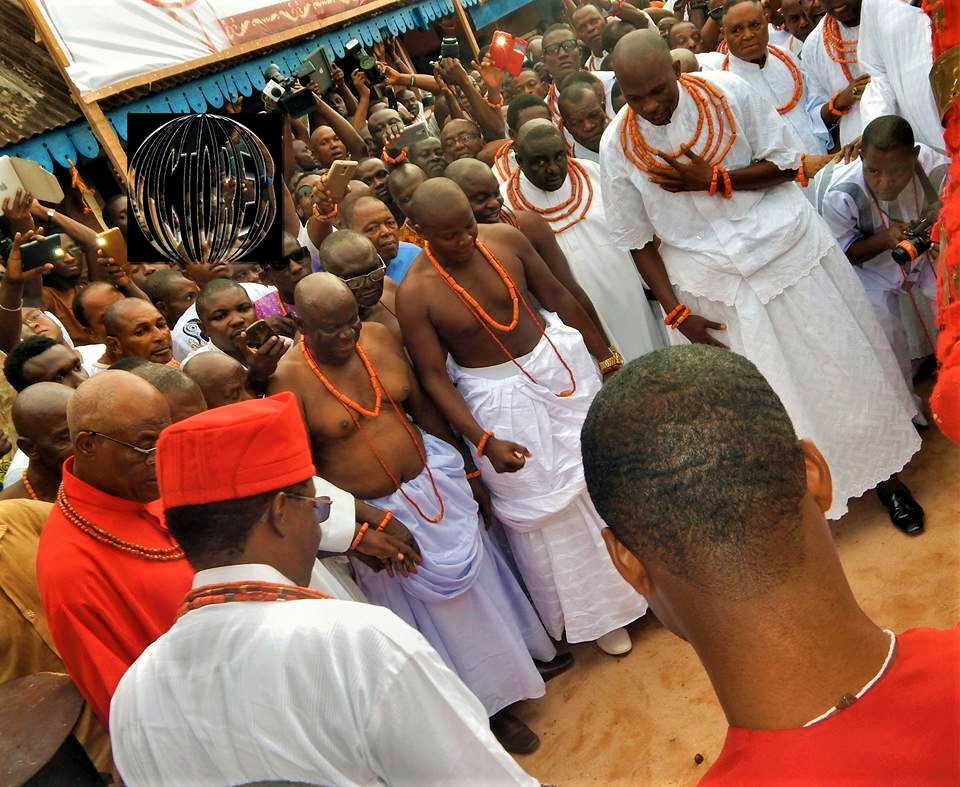
Red and white, two central colours in the aesthetics of Benin royalty and traditional aristocracy, define the regalia of the chiefs and the Crown Prince, the red of the blood of life, the white of purity, correlative enablements in humanity's struggle for both survival and transformation of the basic forms of existence, the richly constructed red beads an insignia of office.
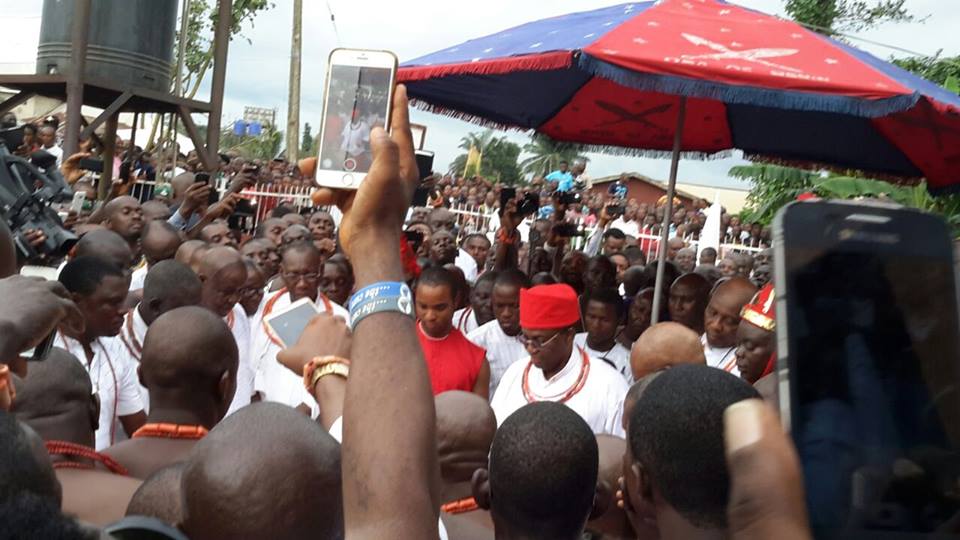
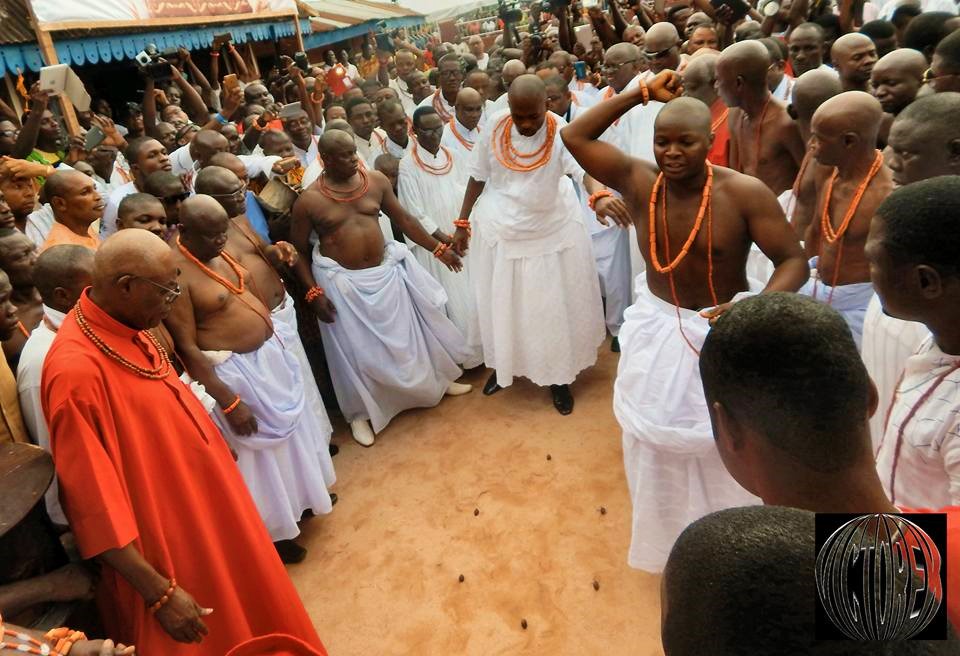
Picture by Victor Ekhator.
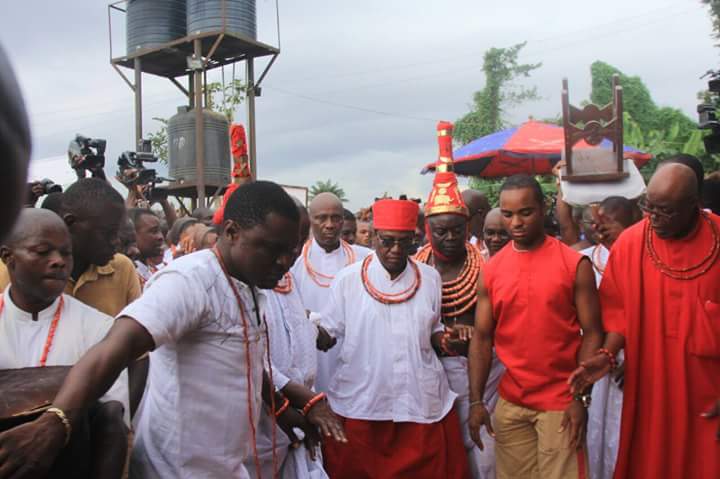
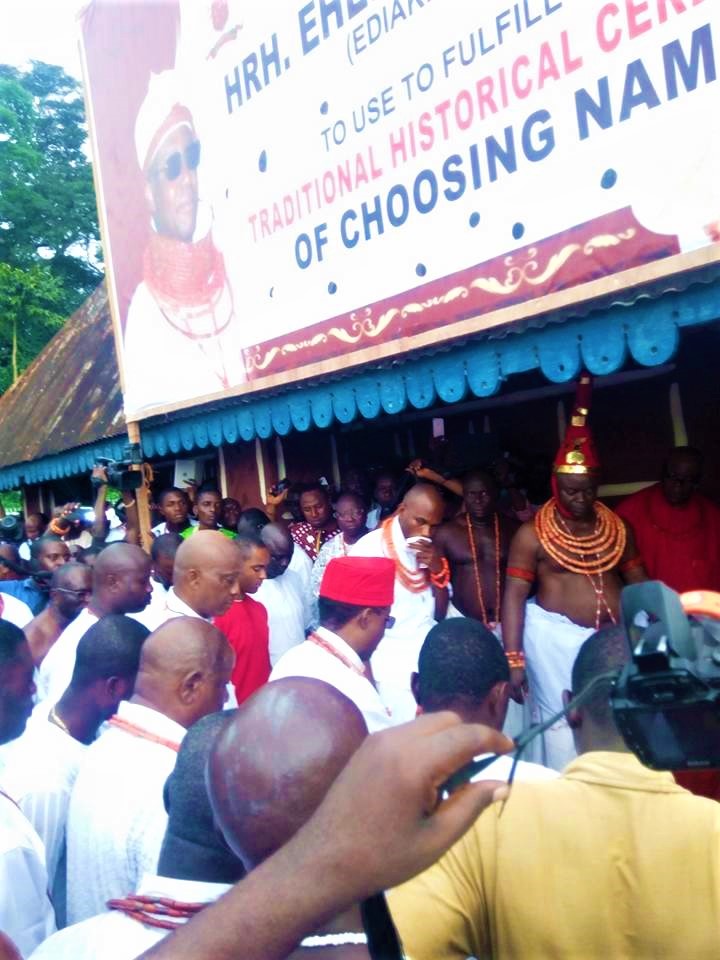
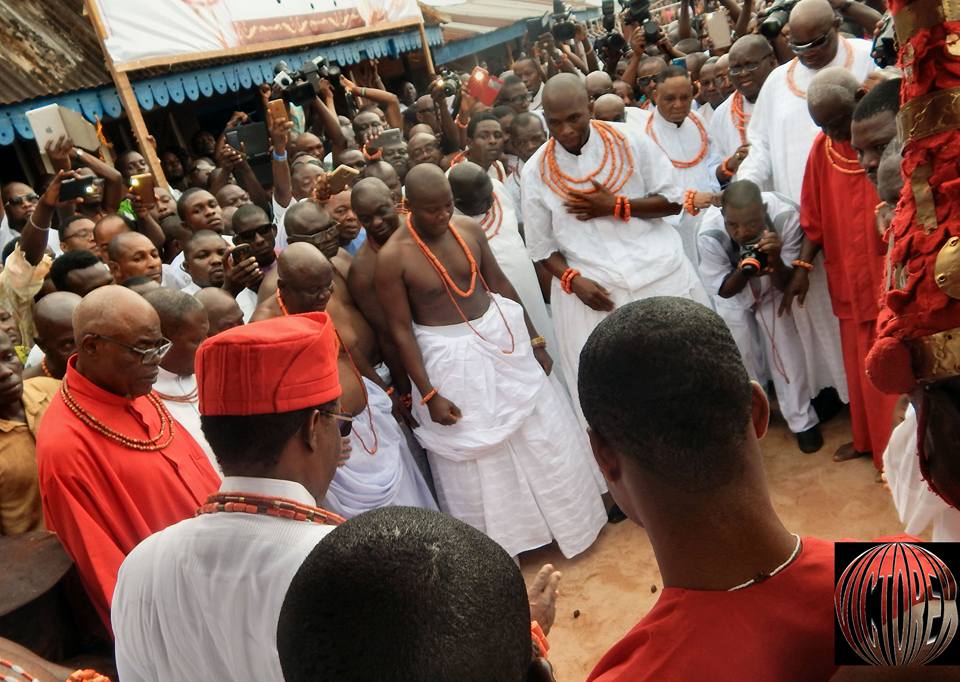
Game Climatic
Another particularly powerful shot by Victor Ekhator. The regal bearing of both central figures, the Edigin and the Crown Prince, defines the visual force of the picture space. The vantage point of the picture, looking down on the pleasurably tense moment from above, thereby viewing the participants from a point suggesting an omni perspective integrating the scene's varied semiotic expressions and possibilities, like a transcendental divine eye, makes it a great image.
The picture projects the convergence of several histories in a powerful dramatic tradition. through the amazing colour of the spectacle, its ingenious mobilisation of symbolism in concretising history in the present, the convivial tension of the moment, the age difference between both players suggesting their character as symbolisations of offices, agglomerations of semiotic values more than individuals.
Many eyes are focused on the ground where the permutations of possibility unfold. Seeking understanding of present configurations and possible outcomes. Feeding that ground with their gaze and being fed by it. Evoking consciousness projecting the sentient possibilities of cosmos and further enriching cosmos through the restless curiosity of consciousness. The game exists as a construct created by semiotic engineers for actualization by those who play and those who watch, even as the players and watchers of the game and the theater of existence within which they play out their lives are themselves constructs of something barely known, its character much disputed. Anyone who peers into that cosmological abyss, that ground of being where the seeds of possibility unfold, returns with a reorientation of personality, a new name.
Sculptural Resonances
Temporal Conjunctions through Ukhurhe and Ikegobo
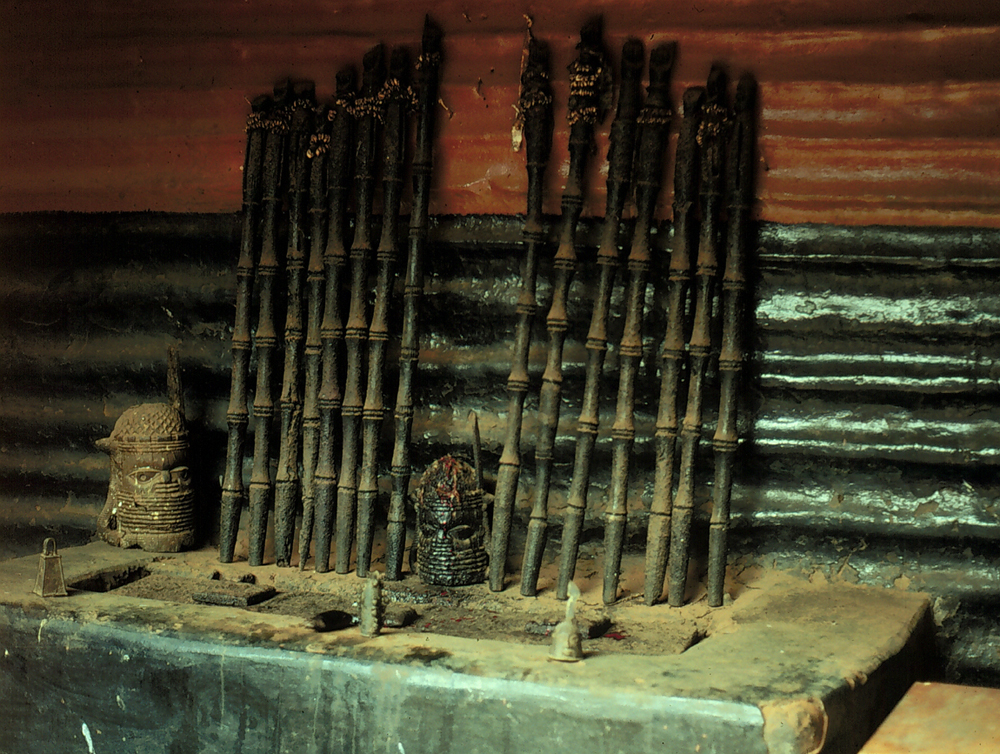
" A Chief’s Altar Commemorating his Paternal Ancestors. Benin City, Nigeria, October, 1981, Photo by Barbara W. Blackmun.
On this patrilineal altar, ukhurhe (carved wooden rattle staffs) rest against the wall, which is also molded of clay. The horizontal corrugations on the wall are permitted only in the homes of prominent chiefs. Each ukhurhe staff represents a specific person in the lineage. When the base of the ukhurhe is struck against the ground, it makes a rattling sound that alerts an ancestral spirit that prayers are being offered on his behalf. An altar is often decorated with brass or wooden commemorative heads, and brass bells are used to signal that ceremonies have begun. In the past, the highest ranking chiefs added matched pairs of carved elephant’s tusks. The most elaborate of these ancestral shrines were in the Oba’s palace.-Barbara W. Blackmun,'Art and Rule in the Benin Kingdom'."
Among other sources, R.E. Bradbury's "Ezomo's Ikegobo and the Benin Cult of the Hand" is iconic in the visual and verbal depiction of this strategy of symbolizing human creativity through the instrumentality of the hand, a strategy also demonstrated by the Igbo ikenga and the Urhobo ivri, cognate civilizations whose structurations of meaning in material forms and ideas reinforce each other.
"Throughout Edo history, coppery brass [ of which this work is made] has been considered more precious than gold. Its reddish color suggests the heat of fire, the fierceness of combat, and the sanctity of the life force present in blood, while its reflective surface offers glimpses into the elusive world of spirits and deities"-Barbara Winston Blackmun, "Icons and Emblems in Ivory: An Altar Tusk from the Palace of Old Benin".Art Institute of Chicago Museum Studies. 23 (2): 148–163+197–198.152.Top left image from "Altar to the Hand (ikegobo) of Ezomo Ehenua" from Goldwater Library wiki, with rich textual sources on ikegobo. All other images from "Oba with Animals"-The Metropolitan Museum of Art. Accessed 8/11/2016.

"Carved elephant tusks [ suggested or exemplified by the ivory tusk in this image] function as a visual bridge between agbon, the material realm, and erinmwin, the world of spirits and ancestors. The whiteness of the ivory tusk is like orhue, a pure, white, kaolin clay considered to be the essence of harmony and spirituality. Orhue is ubiquitous in Edo rituals; it is applied to the faces and bodies of participants in ceremonies, blown into the air in powdered form as purification, painted in sacred designs on shrine floors, and mixed into the food offered to worshipers.
The figures who surround the base of the spiraling arc of this sculpture ground the abstract form in relatively concrete though still highly symbolic expressions of the creative eminence of the person celebrated by the sculpture, an elaborate attired figure, like a crowned Oba, his hands held as attending chiefs do for the Oba on particular ceremonial occasions, as other figures, members of the Oba's court or society at large, are spaced round the circle base.

Crown Prince Supported on Both Sides During Coronation Trek
The vertically placed ukhurhe staffs of the Benin ancestral shrine may be interpreted as suggesting movement in time represented by the relationship between the bottom and top of the staff, both pointing into space. The space to which the bottom of the staff is oriented may be seen as suggesting the existence of the past as a structure of occurrences that have receded into invisibility while the top of the staff may be perceived as directed to space symbolizing the future as a zone of imagined possibilities.


Image on top is of " 'Rattle Staff: Oba Akenzua I Standing on an Elephant (Ukhurhe)'. 1725–50. Bronze, copper, iron. In the Benin kingdom of southern Nigeria, rattle staffs, or ukhurhe, are an essential feature of Benin ancestral altars, whether for kings, chiefs, or commoners. These staffs have a hollow rattle chamber near the summit, and they are shaken while uttering prayers at the altars to attract the attention of the ancestors. Ukhurhe may be made of wood or brass, although the brass examples are found only on royal altars.
This staff was created to memorialize Akenzua I, an Oba (king) who ruled the Benin kingdom in the early eighteenth century. A rebel chief called Iyase n'Ode challenged Akenzua's reign and civil war ensued. With the help of his military commander, or Ezomo, Akenzua ultimately emerged victorious, and the iconography displayed on this ukhurhe refers to this military triumph.



